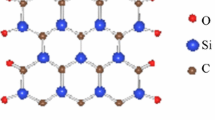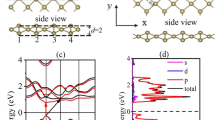Abstract
In this study, we performed a density functional theory based investigation of the structural, electronic, and optical properties of a stanane, fully hydrogenated stanene SnH, and armchair stanane nanoribbons ASnHNRs. Our full geometry optimization calculations show stanane has 0.84 Å buckled height and the buckled structure is preserved in ASnHNRs. The optimized lattice parameter of stanane, Sn–Sn, and Sn–H bond length are 4.58 Å, 2.75Å, and 1.73 Å, respectively. Electronic structure calculations show that stanane is a moderate-band-gap semiconductor with a direct band gap of 1.2 eV and ASnHNRs are wide-band-gap semiconductors. The band gap of ASnHNRs decreases as the ribbons width increases. We investigated the optical properties for two directions of polarization. For perpendicular-polarized light, the imaginary part of dielectric function \(\varepsilon _2(\omega )\) of stanane peaks between 5 and 10 eV; while for the parallel-polarized light, the peaks are seen in a wide range of energy. According to the results, stanane is a good absorptive matter, especially for visible regions of the electromagnetic spectrum. The presence of anisotropy with respect to the type of light polarization is observed in ASnHNRs also. In these structures, the main peak of \(\varepsilon _2(\omega )\) is located at 3.4 eV for parallel- and in 6–8 eV for perpendicular-polarized light.










Similar content being viewed by others
References
Y. Zhang, Y.-W. Tan, H.L. Stormer, P. Kim, Experimental observation of the quantum Hall effect and Berry’s phase in graphene. Nature 438(7065), 201–204 (2005). https://doi.org/10.1038/nature04235
C. Lee, X. Wei, J.W. Kysar, J. Hone, Measurement of the elastic properties and intrinsic strength of monolayer graphene. Science 321(5887), 385–388 (2008). https://doi.org/10.1126/science.1157996
Y.S. Dedkov, M. Fonin, Electronic and magnetic properties of the graphene-ferromagnet interface. New J. Phys. 12(12), 125004 (2010). https://doi.org/10.1088/1367-2630/12/12/125004
L. Jiao, L. Zhang, X. Wang, G. Diankov, H. Dai, Narrow graphene nanoribbons from carbon nanotubes. Nature 458(7240), 877–880 (2009). https://doi.org/10.1038/nature07919
M.Y. Han, B. Özyilmaz, Y. Zhang, P. Kim, Energy. Phys. Rev. Lett. 98(20), 206805 (2007). https://doi.org/10.1103/PhysRevLett.98.206805
Z. Chen, Y.-M. Lin, M.J. Rooks, P. Avouris, Graphene nano-ribbon electronics. Phys. E Low-dimension. Syst. Nanostruct. 40(2), 228–232 (2007). https://doi.org/10.1016/j.physe.2007.06.020
V. Barone, O. Hod, G.E. Scuseria, Electronic. Nano Lett. 6, 2748–2754 (2006). https://doi.org/10.1021/nl0617033
C. Ataca, S. Ciraci, Perpendicular growth of carbon chains on graphene from first-principles. Phys. Rev. B 83(23), 235417 (2011). https://doi.org/10.1103/PhysRevB.83.235417
A.M. Suarez, Theory and simulation of atomic hydrogen, fluorine, and oxygen on graphene. https://etda.libraries.psu.edu/catalog/15218
Z. Wang, J. Xiao, M. Li, Adsorption of transition metal atom on zigzag graphene nanoribbon. Appl. Phys. A 110(1), 235–239 (2013). https://doi.org/10.1007/s00339-012-7119-8
Y.H. Lu, W. Chen, Y.P. Feng, P.M. He, T. Tuning, J. Phys. Chem. B 113(1), 2–5 (2009). https://doi.org/10.1021/jp806905e
V. Barone, O. Hod, G.E. Scuseria, Electronic. Nano Lett. 6(12), 2748–2754 (2006). https://doi.org/10.1021/nl0617033
A. Martín, P. Batalla, J. Hernández-Ferrer, M.T. Martínez, A. Escarpa, Graphene oxide nanoribbon-based sensors for the simultaneous bio-electrochemical enantiomeric resolution and analysis of amino acid biomarkers. Biosens. Bioelectron. 68, 163–167 (2015)
F. Schedin, A.K. Geim, S.V. Morozov, E.W. Hill, P. Blake, M.I. Katsnelson, K.S. Novoselov, Detection of individual gas molecules adsorbed on graphene. Nat. Mater. 6(9), 652–655 (2007). https://doi.org/10.1038/nmat1967
S. Guo, Graphene-Based Material Systems for Nanoelectronics and Energy Storage Devices, Ph.D. thesis, UC Riverside (2012). https://escholarship.org/uc/item/0qk8m6q5
A. Candini, S. Klyatskaya, M. Ruben, W. Wernsdorfer, M. Affronte, Graphene spintronic devices with molecular nanomagnets. Nano Lett. 11(7), 2634–2639 (2011). https://doi.org/10.1021/nl2006142
Y.-E. Yang, Y.-R. Yang, X.-H. Yan, Universal optical properties of graphane nanoribbons: a first-principles study. Phys. E Low-dimension. Syst. Nanostruct. 44, 1406–1409 (2012). https://doi.org/10.1016/j.physe.2012.03.002
Y. Li, Z. Zhou, P. Shen, Z. Chen, Structural and electronic properties of graphane nanoribbons. J. Phys. Chem. C 113(33), 15043–15045 (2009). https://doi.org/10.1021/jp9053499
H. Okamoto, Y. Sugiyama, H. Nakano, Synthesis and modification of silicon nanosheets and other silicon nanomaterials. Chem. Eur. J. 17(36), 9864–9887 (2011). https://doi.org/10.1002/chem.201100641
F.-F. Zhu, W.-J. Chen, Y. Xu, C.-L. Gao, D.-D. Guan, C.-H. Liu, D. Qian, S.-C. Zhang, J.-F. Jia, Epitaxial growth of two-dimensional stanene. Nat. Mater. 14(10), 1020–1025 (2015). https://doi.org/10.1038/nmat4384
S. Saxena, R.P. Chaudhary, S. Shukla, Stanene: atomically thick free-standing layer of 2d hexagonal tin. Sci. Rep. 6, 31073 (2016). https://doi.org/10.1038/srep31073
M. Modarresi, A. Kakoee, Y. Mogulkoc, M.R. Roknabadi, Effect of external strain on electronic structure of stanene. Comput. Mater. Sci. 101, 164–167 (2015). https://doi.org/10.1016/j.commatsci.2015.01.039
N.J. Roome, J.D. Carey, Beyond graphene: stable elemental monolayers of silicene and germanene. ACS Appl. Mater. Interfaces 6, 7743–7750 (2014). https://doi.org/10.1021/am501022x
M. Fadaie, N. Shahtahmassebi, M.R. Roknabad, Effect of external electric field on the electronic structure and optical properties of stanene. Opt. Quant. Electron. 48(9), 440 (2016). https://doi.org/10.1007/s11082-016-0709-5
W. Wei, Y. Dai, B. Huang, T. Jacob, Many-body effects in silicene, silicane, germanene and germanane. Phys. Chem. Chem. Phys. 15(22), 8789–8794 (2013). https://doi.org/10.1039/C3CP51078F
K.L. Low, W. Huang, Y. Yeo, G. Liang, Ballistic transport performance of silicane and germanane transistors. IEEE Trans. Electron. Dev. 61(5), 1590–1598 (2014). https://doi.org/10.1109/TED.2014.2313065
H.L. Zhuang, A.K. Singh, R.G. Hennig, Computational discovery of single-layer III–V materials. Phys. Rev. B 87, 165145 (2013)
B. Peng, D. Zhang, H. Zhang, H. Shao, G. Ni, Y. Zhu, H. Zhu, The conflicting role of buckled structure in phonon transport of 2d group-IV and group-V materials. Nanoscale 9(22), 7397–7407 (2017)
B. Peng, H. Zhang, H. Shao, Y. Xu, X. Zhang, H. Zhu, Low lattice thermal conductivity of stanene. Sci. Rep. 6, 20225 (2016)
P.B. Johnson, R.W. Christy, Optical. Phys. Rev. B 6(12), 4370–4379 (1972). https://doi.org/10.1103/PhysRevB.6.4370
P. Ravindran, A. Delin, B. Johansson, O. Eriksson, J. Wills, Electronic structure, chemical bonding, and optical properties of ferroelectric and antiferroelectric nano 2. Phys. Rev. B 59(3), 1776 (1999)
S.-S. Li, C.-W. Zhang, Tunable electronic structures and magnetic properties in two-dimensional stanene with hydrogenation. Mater. Chem. Phys. 173, 246–254 (2016). https://doi.org/10.1016/j.matchemphys.2016.02.010
M. Fadaie, N. Shahtahmassebi, M.R. Roknabad, O. Gulseren, First-principles investigation of armchair stanene nanoribbons. Phys. Lett. A 382(4), 180–185 (2018). https://doi.org/10.1016/j.physleta.2017.11.018
Acknowledgements
We acknowledge support by the Scientific and Technological Research Council of Turkey (TÜBİTAK), Grant No. (117F097) and by the EU-COST Action (CA16221).
Author information
Authors and Affiliations
Corresponding author
Additional information
Publisher's Note
Springer Nature remains neutral with regard to jurisdictional claims in published maps and institutional affiliations.
Rights and permissions
About this article
Cite this article
Fadaie, M., Dideban, D. & Gülseren, O. Electronic and optical properties of stanane and armchair stanane nanoribbons. Appl. Phys. A 126, 460 (2020). https://doi.org/10.1007/s00339-020-03584-5
Received:
Accepted:
Published:
DOI: https://doi.org/10.1007/s00339-020-03584-5




